September 29, 2025

The article underscores the critical role of compound schedules of reinforcement for Board Certified Behavior Analysts (BCBAs) in enhancing therapeutic outcomes in Applied Behavior Analysis (ABA) therapy.
Did you know that the demand for BCBAs has surged in recent years? This trend highlights the necessity for BCBAs to utilize these schedules effectively.
By tailoring interventions to meet individual client needs, BCBAs can significantly boost engagement, motivation, and skill acquisition.
Research supports this approach, demonstrating that personalized strategies lead to notable increases in effectiveness.
As the field evolves, it becomes imperative for BCBAs to adopt these methods to ensure optimal client outcomes.
The landscape of Applied Behavior Analysis (ABA) therapy is experiencing a significant transformation, marked by a remarkable 25% projected increase in demand for Board Certified Behavior Analysts (BCBAs) by 2026. This surge underscores the critical need for skilled professionals and highlights the essential role of effective reinforcement strategies in enhancing therapeutic outcomes.
As BCBAs navigate this evolving field, they face the challenge of mastering compound schedules of reinforcement—complex frameworks that can profoundly influence client behavior and learning.
How can understanding and implementing these sophisticated reinforcement techniques empower BCBAs to elevate their practice and achieve better results for their clients?
In the rapidly expanding field of Applied Behavior Analysis therapy, the demand for Board Certified Behavior Analysts (BCBAs) is projected to surge by an astonishing 25% by 2026. This significant growth underscores the critical role of Hire ABA, a specialized recruitment platform that connects qualified behavior analysts with premier job opportunities. As the hiring landscape evolves, Hire ABA streamlines the recruitment process, enabling professionals to easily discover positions that align with their skills and career aspirations.
Consider this: there was an impressive 58% rise in job listings for BCBAs from 2023 to 2024. This trend is indicative of a broader employment expansion, with an for BCBAs over the next decade. The platform not only facilitates access to these opportunities but also ensures that candidates can navigate their career paths in ABA therapy with confidence and ease.
Moreover, while the average salary for BCBAs hovers around $89,075 annually, entry-level positions typically start at approximately $47,500, with experienced professionals earning upwards of $150,000, particularly in high-demand regions. By leveraging the resources available through Hire ABA, job seekers can tap into a wealth of tailored opportunities, positioning themselves competitively in this dynamic job market.
Are you ready to take the next step in your career? Hire ABA is your gateway to a future filled with potential and growth in the field of behavior analysis. Don’t miss out on the chance to connect with leading employers seeking your expertise.
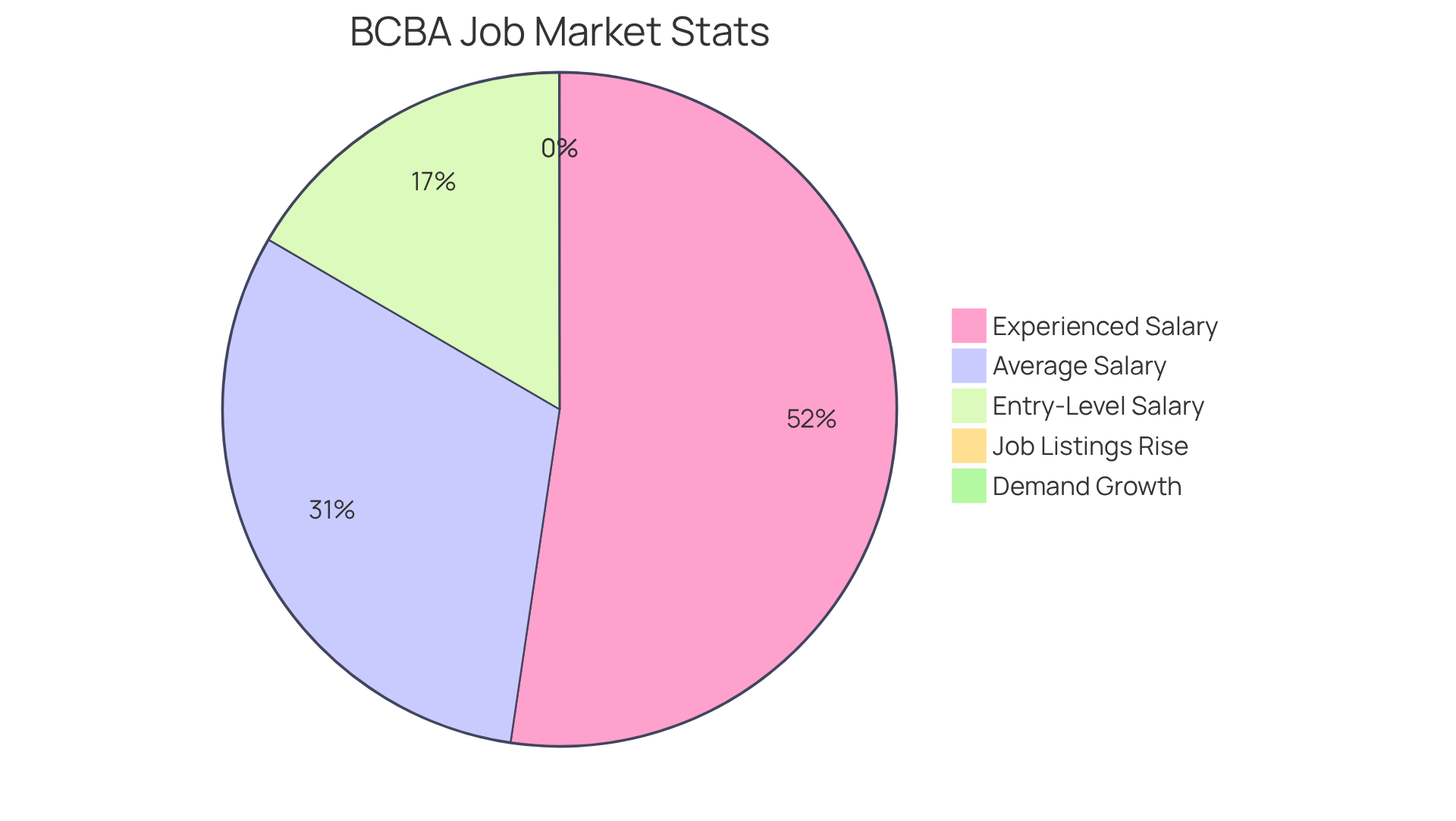
A simultaneous arrangement of rewards is crucial in the field of behavior analysis, allowing for the comparison of various actions and their associated incentives. For instance, a Board Certified Behavior Analyst (BCBA) may utilize a concurrent plan to determine which of two behaviors is more likely to be reinforced under differing conditions. This method not only aids in identifying the most effective reinforcement strategies but also empowers BCBAs to , thereby maximizing therapeutic outcomes.
Research indicates that simultaneous arrangements significantly influence response rates and patterns; approximately 60% of individual log values in concurrent arrangement studies fell within the range of -0.10 to +0.10, underscoring their effectiveness. Recent studies have shown that these routines enhance motivation and engagement, particularly among children with autism, by offering immediate and meaningful outcomes for specific actions.
As Federico Sanabria observed, "higher opportunity costs changed start and stop times in directions consistent with reinforcement optimization." By understanding and applying simultaneous plans, BCBAs can develop more effective and personalized therapy sessions, ultimately leading to improved behavioral outcomes. Moreover, these arrangements have practical applications in real-world contexts, such as educational settings where students choose between activities like math problems or reading stories, further illustrating their significance beyond therapy.

Various plans of incentive include compound schedules of reinforcement, which consist of two or more distinct arrangements introduced in succession, allowing analysts to promote actions under different circumstances. This strategy empowers BCBAs to tailored to their clients' specific needs, thereby enhancing the effectiveness of behavior modification strategies. In contrast, mixed arrangements utilize various reward systems in a random or alternating order without correlated discriminative stimuli, which can be described as implementing compound schedules of reinforcement, fostering a dynamic reward environment. For instance, a jiu jitsu instructor may initially provide continuous reinforcement for a drill, then shift to fixed ratio reinforcement, and revert to continuous reinforcement without the student being aware of the changes. This flexibility can lead to improved client outcomes by accommodating individual learning styles and preferences.
Recent studies highlight the growing trend of employing compound schedules of reinforcement in clinical settings, showcasing their effectiveness in managing both appropriate and problematic behaviors. Research indicates that only 2% of applications utilized compound schedules of reinforcement involving multiple timelines with over two elements, underscoring the complexity of these arrangements in practice. Furthermore, 35.4% of various multiple-timing applications incorporated short intervals of extinction alternating with extended intervals of reinforcement, illustrating the practical applications and outcomes of compound schedules of reinforcement in behavior modification. Additionally, insights from certified analysts emphasize the importance of understanding the nuances of mixed arrangements, as these can be considered compound schedules of reinforcement that provide a more engaging and adaptive framework for behavior modification. By leveraging the concepts of various and combined timetables, BCBAs can craft interventions that not only address maladaptive behaviors but also foster the development of functional skills in their clients. It is crucial to consider the potential resurgence of problematic behaviors when alternative support is withdrawn, as this can significantly impact the effectiveness of interventions.
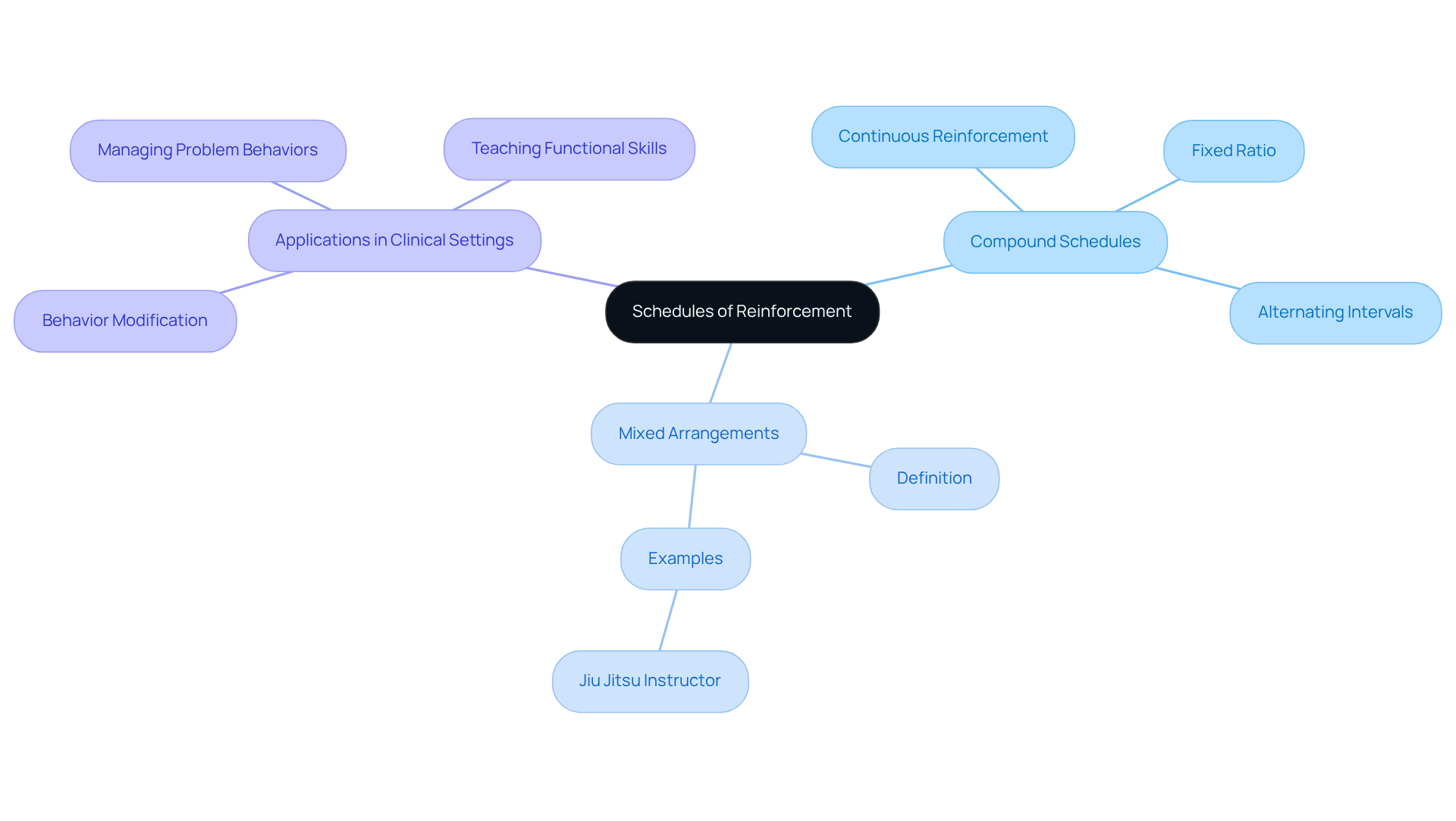
Chained systems of reinforcement require the completion of a series of actions before reinforcement is delivered, while tandem systems involve a sequence of actions without a clear signal for reinforcement. For example, a BCBA may implement a chained plan to guide a client through a multi-step task, reinforcing each completed step.
Studies indicate that this method, particularly when integrated with (FCT), can lead to an impressive 80% reduction in problem behaviors from baseline, underscoring its effectiveness in skill acquisition.
As Hagopian et al. observed, 'a chained-schedule approach can be advantageous because individuals learn to complete tasks or follow instructions while also accessing breaks appropriately through the FCR.'
By mastering advanced techniques such as the dense-to-lean plan thinning and probabilistic delay-tolerance method, Board Certified Behavior Analysts are equipped to manage complex actions effectively, fostering significant skill development in their clients.
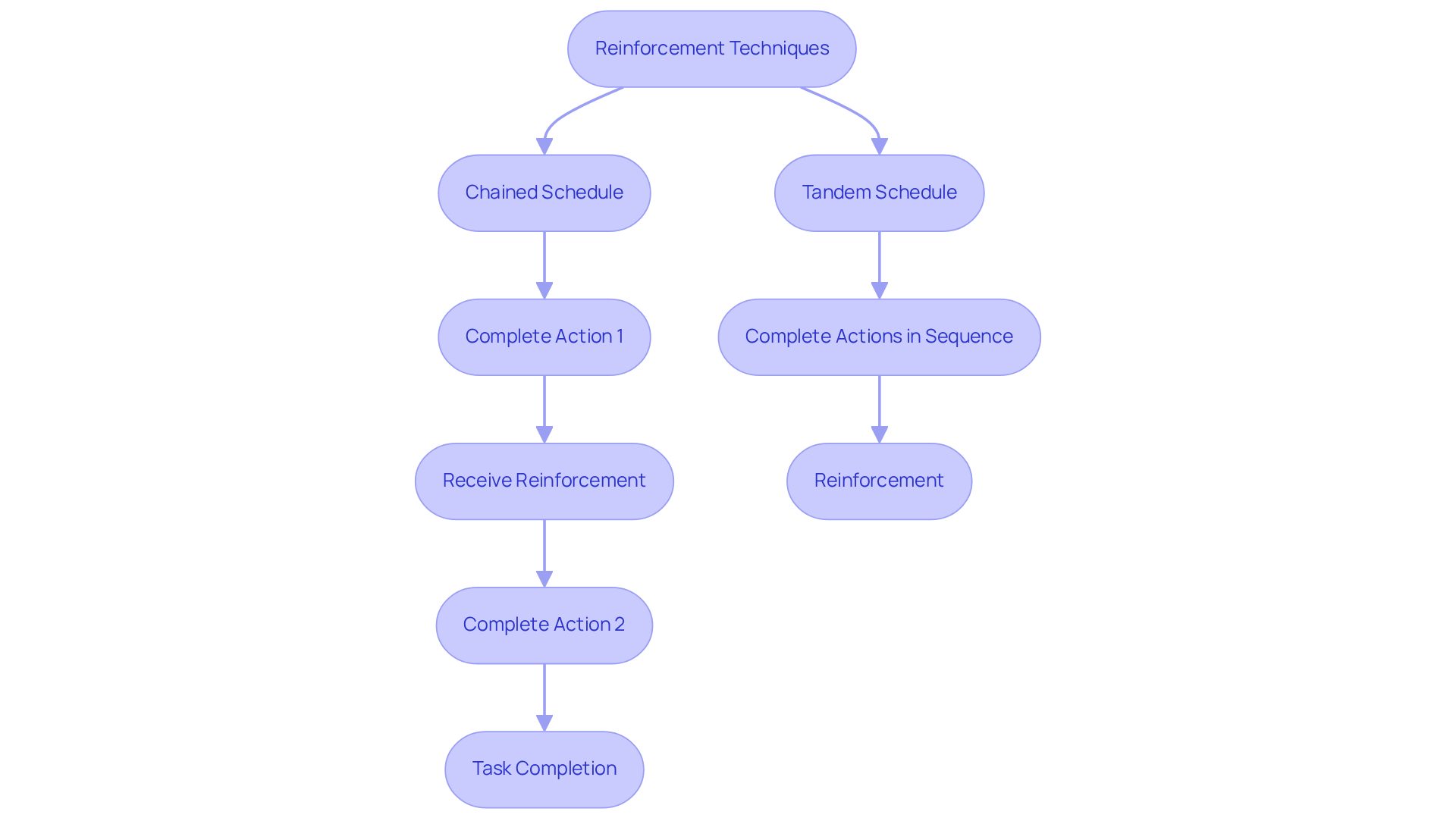
Alternative patterns of reinforcement offer a flexible method by permitting reinforcement to be given upon the completion of either of two behaviors. This flexibility enables BCBAs to encourage clients to engage in one of two desired actions, thereby accommodating individual preferences and enhancing motivation. For instance, a BCBA might introduce a different plan where a child can select between finishing a homework task or engaging in a fun activity, positively reinforcing either option. In simultaneous arrangements, each reward condition usually has its own discriminative stimulus (SD), which further highlights the significance of comprehending the context in which these systems function.
In contrast, conjunctive arrangements necessitate the fulfillment of both behaviors before reinforcement is provided. This approach can be particularly effective in promoting , as it requires clients to meet multiple criteria for success. For instance, a BCBA might create a conjunctive plan that requires a child to complete a specific number of math problems and read a book before receiving a reward, thereby reinforcing both academic and reading skills simultaneously.
The adaptability present in alternative timetables empowers behavior analysts to customize interventions to address the distinct requirements of their clients, promoting a more individualized therapeutic experience. As noted by seasoned analysts in the field, "Certified professionals and associates must excel in designing and applying various forms of compound schedules of reinforcement," emphasizing the significance of flexibility in reinforcement methods and their impact on choices based on available alternatives.
Furthermore, the effect of conjunctive arrangements on client behavior can be substantial, as they foster the development of sequential task completion and encourage a structured approach to learning. By comprehending and effectively employing these plans, behavior analysts can significantly boost the efficacy of their interventions, resulting in better outcomes for clients in ABA therapy.
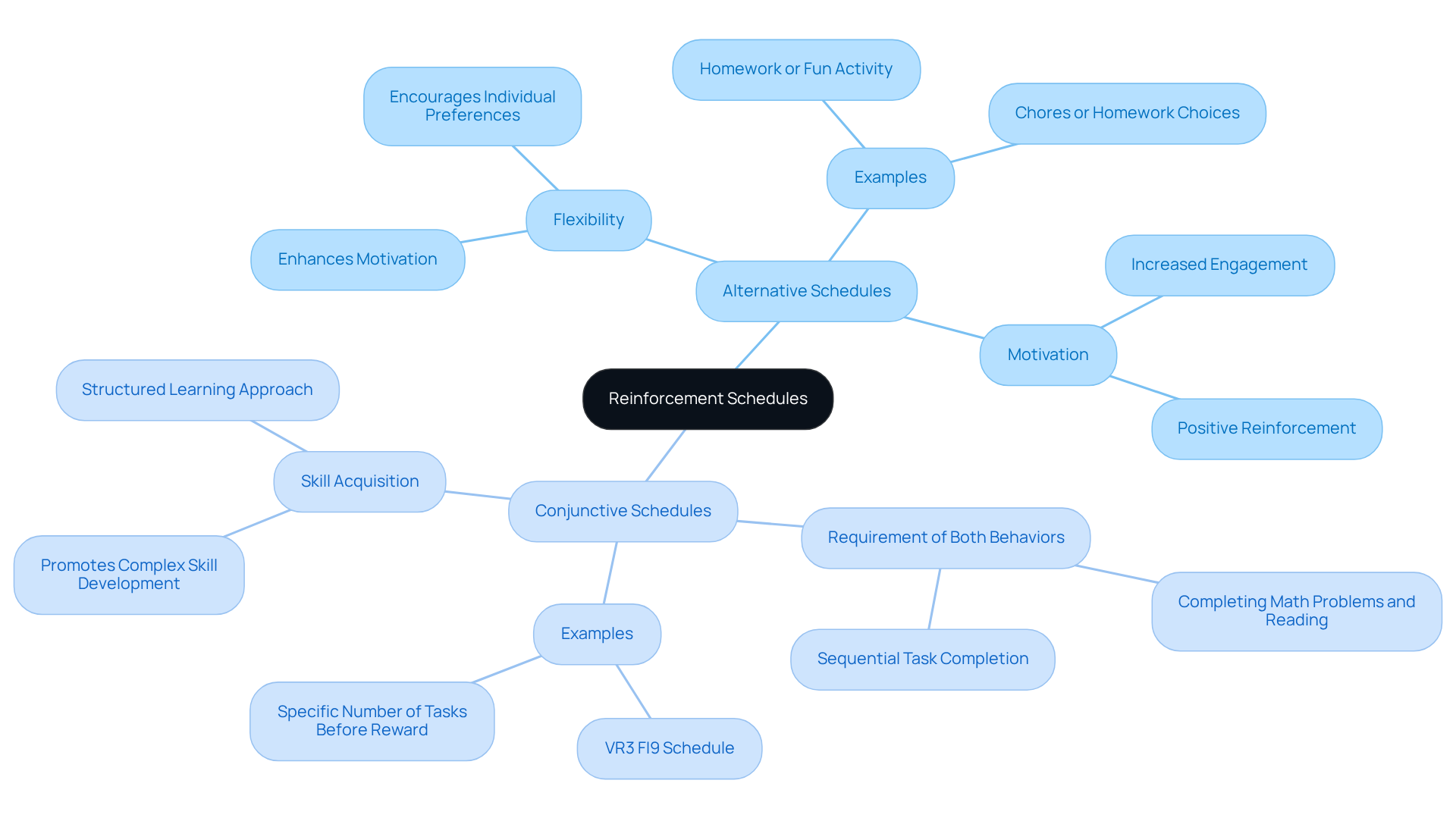
Compound schedules of reinforcement utilize various incentive strategies, allowing Board Certified Behavior Analysts (BCBAs) to create intricate and personalized methods. By leveraging the interaction of compound schedules of reinforcement, BCBAs can create interventions that are not only more effective but also finely tuned to the unique needs of their clients. Research indicates that customized support strategies significantly enhance engagement and learning outcomes, with studies showing that individualized approaches lead to a 25% increase in skill acquisition rates among children with Autism Spectrum Disorder (ASD), as supported by recent findings in the field.
Effective interventions employing compound support strategies showcase their versatility. A case study on token economies illustrates this, revealing that children who received tokens for suitable actions demonstrated a significant increase in motivation and engagement, resulting in lasting changes in conduct. Furthermore, the application of differential incentive techniques has proven successful in decreasing challenging behaviors while encouraging desired actions, as evidenced by various case studies in Applied Behavior Analysis (ABA) therapy.
The significance of compound schedules of reinforcement in ABA cannot be overstated. They provide a framework for behavior analysts to systematically address diverse behavioral needs, fostering resilience and adaptability in learners. To develop effective support strategies utilizing compound plans, BCBAs should evaluate individual preferences through techniques like and consistently track progress, ensuring that the rewards remain pertinent and encouraging. This tailored approach not only enhances therapeutic outcomes but also empowers clients to achieve greater independence and quality of life. As B.F. Skinner pointed out, 'When a reward aligns with a student’s interests, it becomes more motivating, raising the chances that the desired action will occur again.' Healthcare employers are encouraged to implement these strategies in their practices to optimize outcomes for their clients.
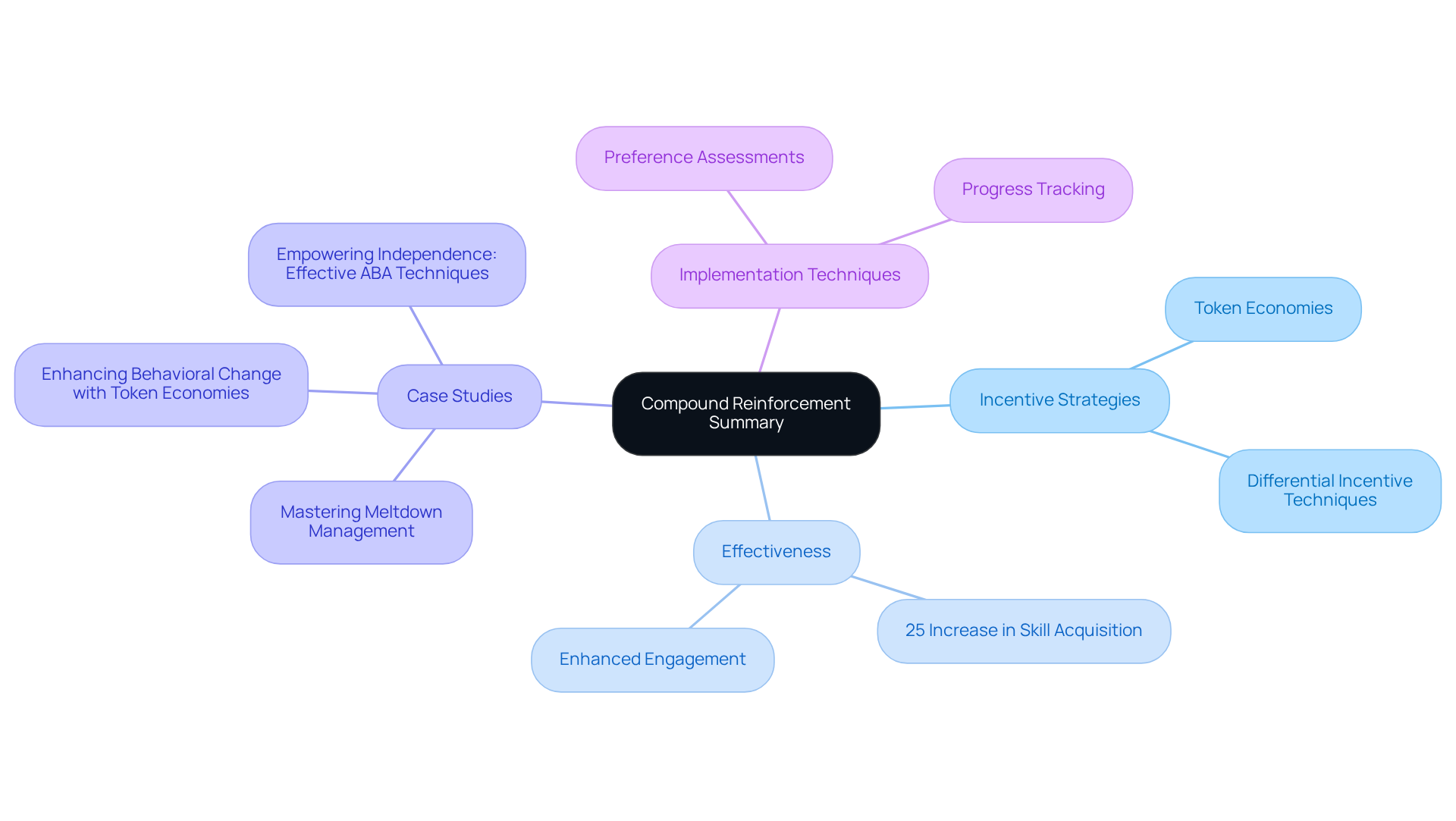
The demand for Board Certified Behavior Analysts (BCBAs) is projected to surge by 25% by 2026, highlighting a critical need for skilled professionals in the field. In Applied Behavior Analysis (ABA) therapy, compound schedules of reinforcement are essential, offering an advanced method for modifying actions. By utilizing a range of support schedules, certified specialists can effectively address the intricacies of client actions, resulting in improved learning outcomes. This increasing demand illustrates the acknowledgment that the use of not only enhances modification results but also promotes greater involvement and motivation among clients. Such strategies could lead to higher salaries and leadership positions in the field.
Consider the impact of employing simultaneous plans, which enable clients to select from various support options, thereby improving their autonomy and participation in the therapeutic process. Moreover, the adaptability of interventions based on compound schedules of reinforcement allows analysts to customize plans to personal preferences, which is crucial for fostering lasting change in conduct. Insights from seasoned behavior analysts reveal that understanding and applying these nuanced incentive strategies can significantly impact client outcomes.
Are you facing challenges in hiring qualified professionals? Staying informed about these strategies can open doors to new opportunities and advancements in your BCBA career. As you consider your career path, remember that leveraging advanced reward strategies not only enhances your practice but also positions you as a leader in the evolving landscape of ABA therapy.
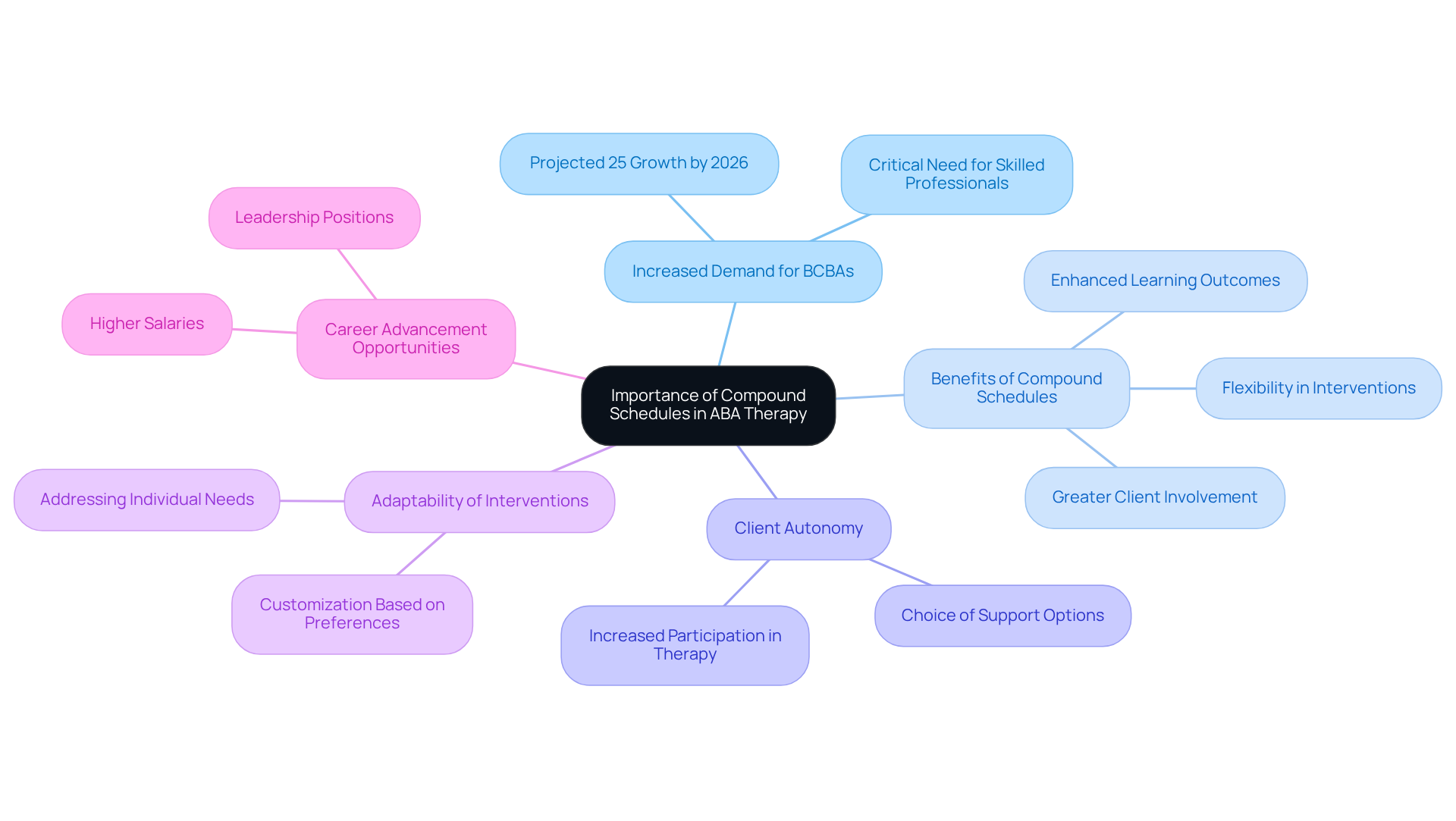
Certified analysts can efficiently apply compound schedules of reinforcement by thoroughly evaluating client actions to determine the most advantageous combinations of systems. Research indicates that 90% of individuals show remarkable progress when caregivers are actively engaged in ABA therapy.
For example, a BCBA may employ a chained arrangement to assist in the learning of a multi-step task while simultaneously using a concurrent method to strengthen various behaviors. This strategic flexibility not only allows for tailored interventions but also significantly enhances client outcomes.
By consistently observing and modifying these plans based on personal progress, including using data gathering techniques such as frequency counts or interval recording, behavior analysts can ensure that their interventions stay pertinent and impactful. This ultimately promotes greater independence and in their clients.
As noted by Macy Rogers, 'The key to successful ABA intervention is understanding the individual within autism,' which underscores the importance of personalized approaches in therapy.
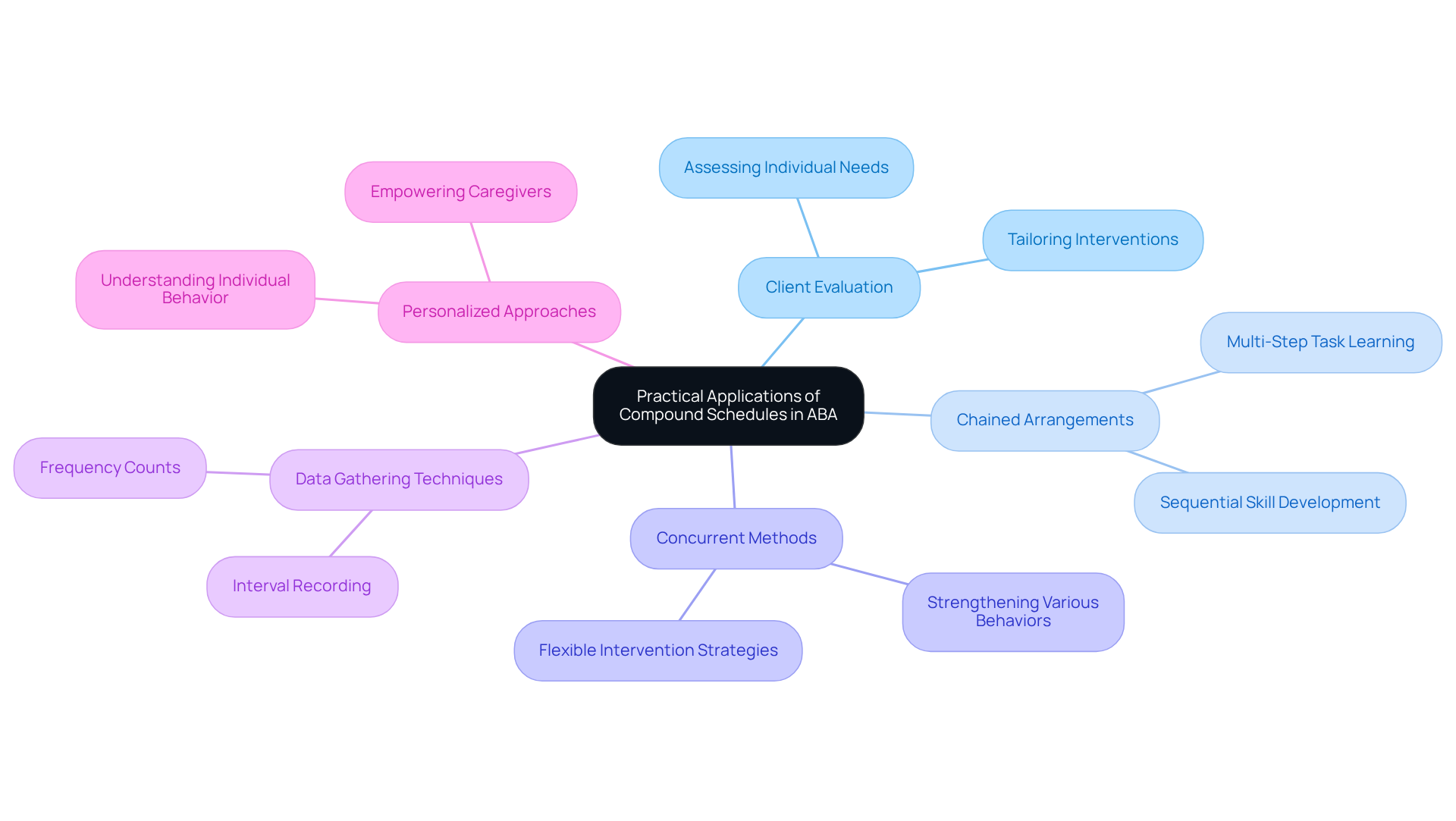
Establishing [compound schedules of reinforcement](https://behavioranalyststudy.com/compound-schedules-of-reinforcement) is increasingly essential for Board Certified Behavior Analysts (BCBAs), given the growing demand for their expertise. One critical concern is the consistency in reinforcement delivery, which is vital for effective behavior modification. Studies indicate that utilizing compound schedules of reinforcement can lead to problematic behaviors diminishing to nearly nonexistent levels, underscoring the importance of precise oversight. Behavior analysts must diligently evaluate client behavior to determine the effectiveness of their chosen strategies and be ready to implement necessary adjustments.
For instance, a conjunctive plan like VR3 FI9 offers rewards after an average of three responses and nine minutes, while an alternative arrangement such as FR6 FI5 provides rewards after six responses or the first response following five minutes. This diversity necessitates careful observation to ensure alignment with the client’s needs. Understanding how individual clients respond to different compound schedules of reinforcement is crucial; insights from behavior analysts reveal that based on these schedules can significantly enhance outcomes.
Moreover, statistics show that 90% of individuals experience substantial progress when recommended hours are fully implemented with active caregiver involvement. This highlights the critical role caregivers play in the reinforcement process. By recognizing these challenges, behavior analysts can proactively tackle potential issues, ultimately improving their practice and the effectiveness of interventions.
Are you facing difficulties in hiring qualified BCBAs? Consider how specialized recruitment platforms like Hire ABA can streamline your hiring process and ensure you have the right professionals to support your clients' needs.
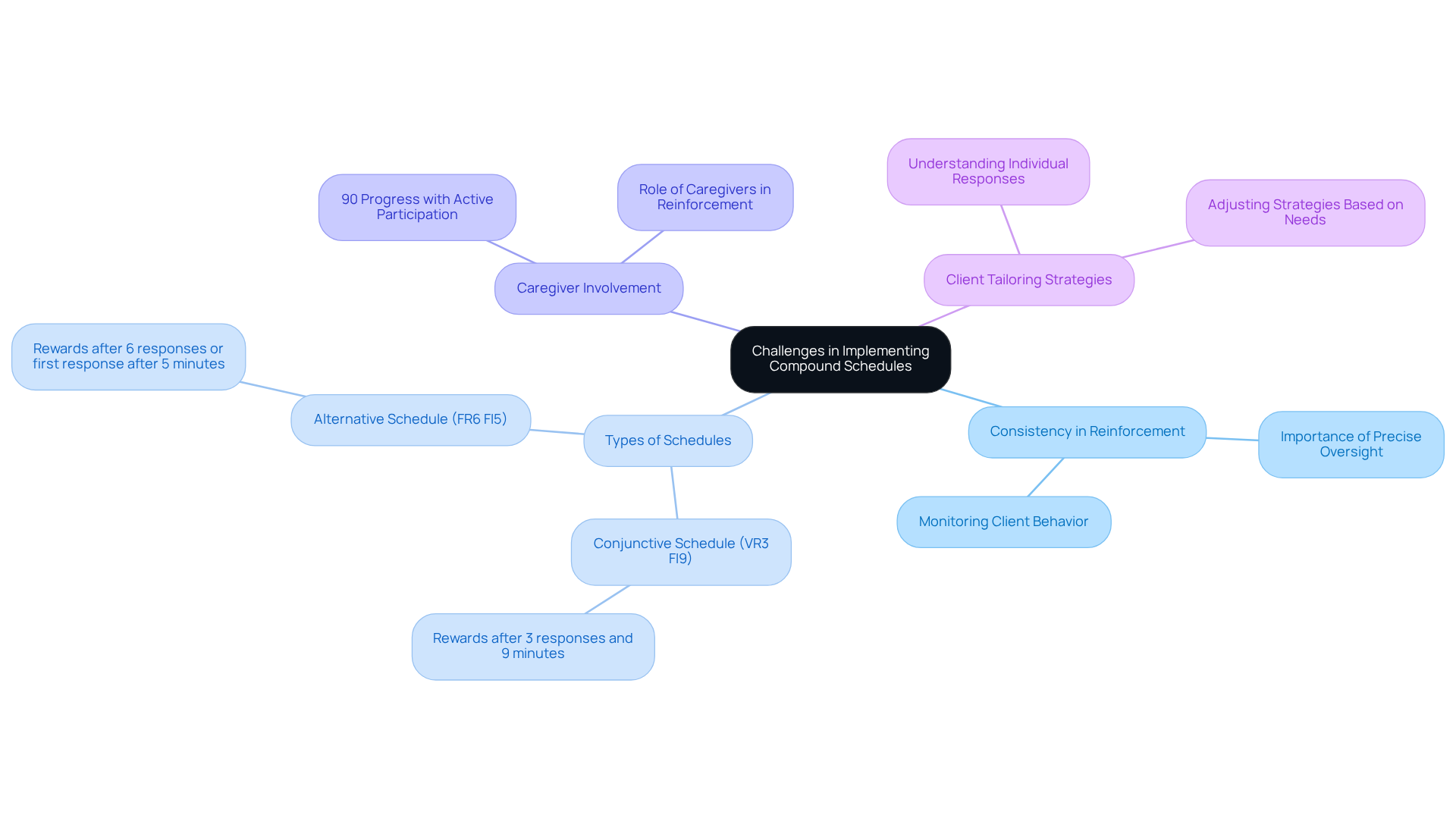
To effectively instruct and reinforce compound systems, Board Certified Behavior Analysts (BCBAs) must prioritize clear and consistent communication. Utilizing visual aids and are crucial strategies. By breaking down intricate plans into manageable steps, clients can better understand expectations, reinforcing their learning.
For instance, fixed interval systems encourage responding as the interval nears, fostering patience. In contrast, variable ratio frameworks create steady, high response rates and resistance to extinction.
Furthermore, offering prompt feedback and support significantly improves the learning process, ensuring clients remain engaged and motivated. These strategies empower BCBAs to efficiently implement complex plans, greatly enhancing client involvement.
Recent statistics indicate that variable ratio schedules can sustain behaviors even with less frequent reinforcement, demonstrating their effectiveness in practice.
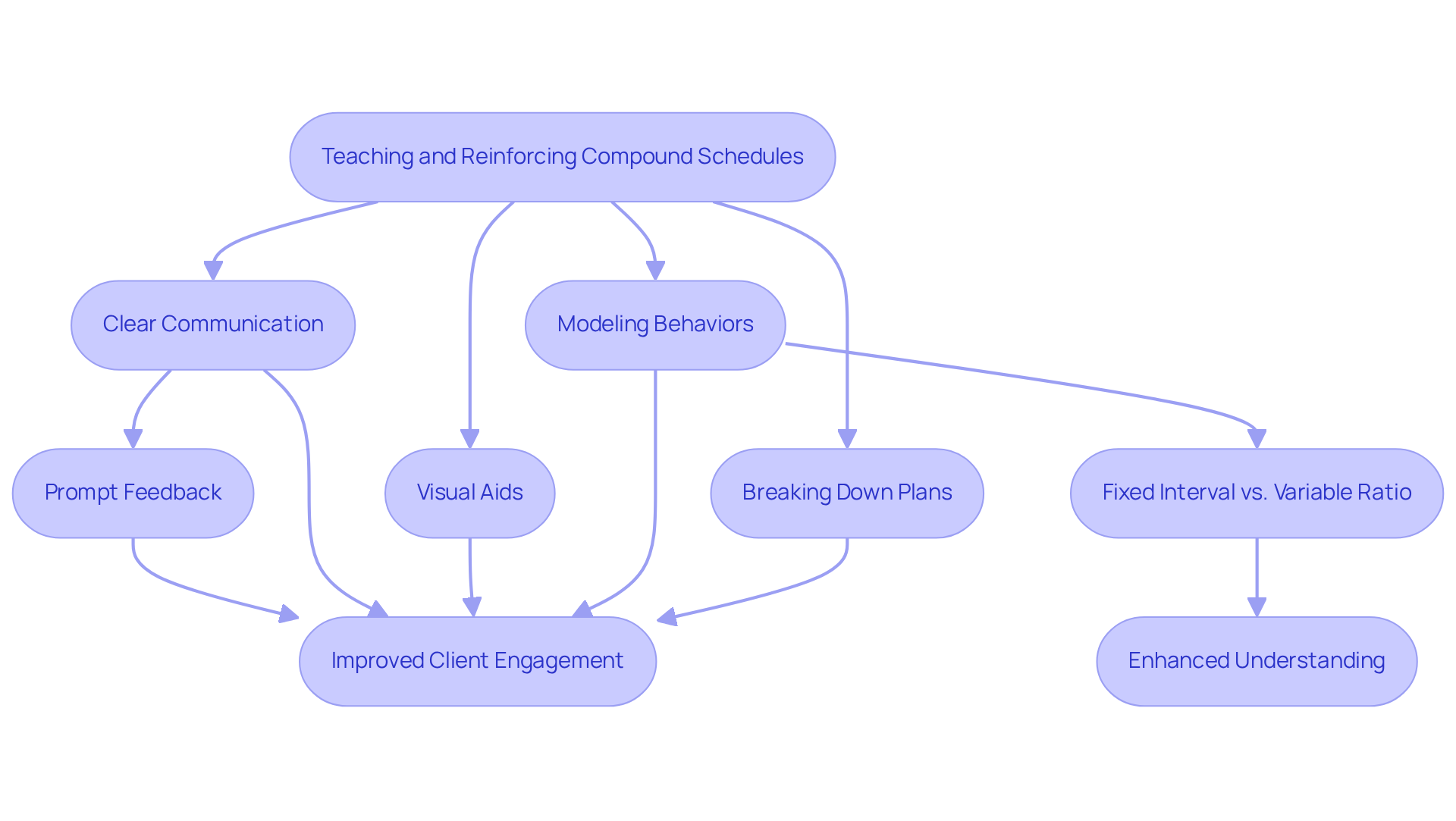
The significance of compound schedules of reinforcement in Applied Behavior Analysis (ABA) therapy is paramount. These sophisticated methods empower Board Certified Behavior Analysts (BCBAs) to tailor interventions that effectively address the unique needs of their clients, ultimately leading to enhanced learning outcomes and improved behavioral modifications. By embracing a variety of reinforcement strategies, BCBAs create a more engaging and adaptive therapeutic environment that fosters client independence and motivation.
Throughout the article, key concepts such as:
schedules have been explored. Each type offers distinct advantages, enabling analysts to customize their approaches based on individual client preferences and behaviors. Research supports the effectiveness of these strategies, demonstrating significant improvements in client engagement and skill acquisition when compound schedules are employed thoughtfully and consistently.
As the demand for skilled BCBAs continues to rise, staying informed about the latest reinforcement techniques is essential. Implementing these advanced strategies not only optimizes therapeutic outcomes but also positions professionals as leaders in the evolving landscape of behavior analysis. By prioritizing personalized approaches and actively engaging clients in their learning processes, BCBAs make a lasting impact on the lives of those they serve, ultimately contributing to a more effective and compassionate ABA practice.
What is Hire ABA and its purpose?
Hire ABA is a specialized recruitment platform designed to connect qualified Board Certified Behavior Analysts (BCBAs) with premier job opportunities in the field of Applied Behavior Analysis therapy.
What is the projected job growth for BCBAs by 2026?
The demand for BCBAs is projected to surge by 25% by 2026.
How much did job listings for BCBAs increase from 2023 to 2024?
There was a 58% rise in job listings for BCBAs from 2023 to 2024.
What is the average salary for BCBAs?
The average salary for BCBAs is approximately $89,075 annually.
What are the salary ranges for entry-level and experienced BCBAs?
Entry-level positions typically start at around $47,500, while experienced professionals can earn upwards of $150,000, especially in high-demand regions.
How does the concurrent schedule of reinforcement work in behavior analysis?
A concurrent schedule of reinforcement allows for the comparison of different behaviors and their associated rewards, helping BCBAs to identify effective reinforcement strategies and tailor interventions to individual needs.
What impact do simultaneous arrangements have on response rates and patterns?
Research indicates that approximately 60% of individual log values in concurrent arrangement studies fall within the range of -0.10 to +0.10, highlighting their effectiveness in influencing response rates and patterns.
How can mixed schedules of reinforcement benefit behavior modification?
Mixed schedules of reinforcement allow BCBAs to use various reward systems in a random or alternating order, accommodating individual learning styles and enhancing the effectiveness of behavior modification strategies.
What is the significance of understanding compound schedules of reinforcement?
Understanding compound schedules enables BCBAs to customize interventions that address both appropriate and problematic behaviors, ultimately leading to improved client outcomes.
Why is it important to consider the potential resurgence of problematic behaviors in interventions?
Considering the potential resurgence of problematic behaviors is crucial because it can significantly impact the effectiveness of interventions when alternative support is withdrawn.
Our expert recruitment strategies and AI-driven sourcing ensure that you receive top-notch candidates quickly, without compromising on quality. Whether you’re looking for BCBAs, Clinical Directors, or RBTs, we’ve got you covered.